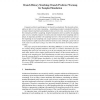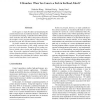406 search results - page 4 / 82 » Boosting Using Branching Programs |
ECCC
2010
13 years 7 months ago
2010
We give new pseudorandom generators for regular read-once branching programs of small width. A branching program is regular if the in-degree of every vertex in it is either 0 or 2...
ESORICS
2012
Springer
11 years 9 months ago
2012
Springer
Tracking information flow in dynamic languages remains an open challenge. It might seem natural to address the challenge by runtime monitoring. However, there are well-known funda...
MICRO
2005
IEEE
14 years 28 days ago
2005
IEEE
Predicated execution has been used to reduce the number of branch mispredictions by eliminating hard-to-predict branches. However, the additional instruction overhead and addition...
HIPEAC
2007
Springer
14 years 1 months ago
2007
Springer
Computer architects and designers rely heavily on simulation. The downside of simulation is that it is very time-consuming — simulating an industry-standard benchmark on today�...
IEEEPACT
2003
IEEE
14 years 19 days ago
2003
IEEE
In this paper, we study the effects of manipulating the architected direction of conditional branches. Through the use of statistical sampling, we find that about 40% of all dyna...


